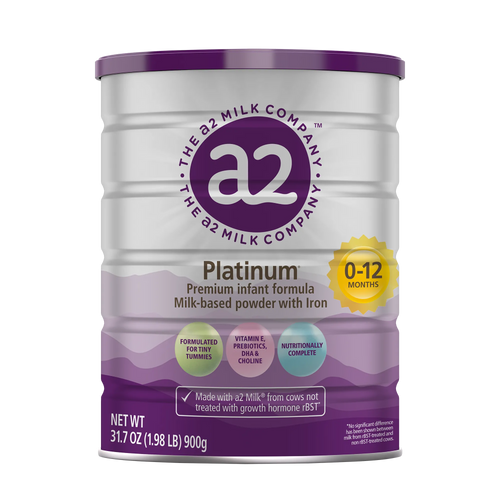The Ultimate Guide To Baby-Led Weaning
Baby-led weaning (BLW) is an approach to introducing solids that encourages babies to self-feed.
The baby-led weaning method fosters the development of crucial eating and self-feeding skills, including picking up food, bringing food to the mouth, chewing, and swallowing. With baby-led weaning, your baby has more autonomy over their food choices, portion sizes, and eating pace, allowing them to respond to their own hunger cues.
Breast milk or infant formula remains the main source of nutrition during this time and should always be offered first at feeding time. Breast milk provides essential nutrients and energy, crucial for maintaining your baby's health as they transition to solid foods.
What is Baby-Led Weaning?
Baby-led weaning (BLW) is a self-feeding approach to introducing solids to your baby. Instead of spoon-feeding purees, you offer appropriately sized finger foods directly on the tray or table, allowing your baby to explore and feed themselves. With BLW, your baby takes the lead, choosing what to eat and setting their own pace. It’s called “baby-led” because your baby can pick up food and eat independently.
Baby-led feeding is crucial for ensuring safety and readiness. Proper supervision and recognizing developmental signs are essential when beginning this method.
According to advocates, there are many benefits of using the baby-led weaning approach to starting solids:
- Eating skills. Learning how to chew first and then swallow.
- Foodie in the making. Exposure to a wide range of foods increases the acceptance of flavors and textures.
- Healthy weight. Reduced risk of childhood obesity by allowing the child to self-regulate how much food is “enough.”
- Fine motor skill development. Eating finger food develops hand-eye coordination with self-feeding, encouraging babies to utilize the pincer grip necessary when picking up food to bring it to their mouths.
- Convenience. Since minimal preparation is needed, baby-led weaning can relieve stress around mealtimes.
- Family bonding. When possible, your whole family can eat the same foods at the same time as your baby.
Following the baby-led weaning approach, you can nurture your baby's independence and foster a positive relationship with food that will benefit them for a lifetime.
Words of Caution for Baby-Led Weaning
While baby-led weaning can be rewarding and beneficial, there are some important aspects to keep in mind when practicing baby-led weaning to ensure a safe and positive experience for you and your baby.
- Expect a Messy Process: Be prepared for meal times to be messy. Babies are learning to self-feed naturally, squish, drop, and throw food as they explore different textures and learn hand-to-mouth coordination. Consider investing in a high-quality bib, a splat mat, and a floor cover to make cleaning up easier.
- Safety First: Choking can be a major concern during baby-led weaning, so taking the necessary precautions is important. Always supervise your baby closely during meals and ensure they sit upright in a highchair or appropriate seating. Offer foods that are soft, easy to chew, and sized appropriately to minimize choking risks.
- Focus on Iron-Rich Foods: Babies require enough iron to support their rapid growth and development, especially after six months of age, when their natural iron stores begin to deplete. It’s essential to include iron-rich foods, such as pureed or finely shredded meat, poultry, beans, lentils, tofu, and fortified cereals, in their diet.
- Monitor Allergies: Introducing new foods one at a time is key to monitoring for allergic reactions. Start with a single new food every three to five days. Watch for signs of an allergic reaction, such as rashes, swelling, vomiting, or respiratory issues, and consult your pediatrician if any concerns arise. Including potential allergens like peanuts, eggs, and shellfish can help reduce the risk of allergies later in life.
- Patience is Key: Self-feeding is a skill that takes time to learn. Some babies might take to BLW quickly, while others need more time to explore and gain confidence. Be patient as they figure out how to pick up food, bring it to their mouths, chew, and swallow. Avoid pressuring or rushing your baby and allow them to go at their own pace.
Not every family will follow the same approach, and that’s okay. Some parents find a combination of spoon-feeding and baby-led weaning works best for their baby. Follow your baby’s cues and your instincts to determine what method feels right for your household. The goal is to create a positive, stress-free environment where your baby learns and can enjoy exploring food.
By considering these considerations, you can create a safe and enjoyable meal experience while fostering your baby’s independence and relationship with food.
When Should I Start Baby-Led Weaning?
All babies are different and will reach developmental milestones with different foods and in their own time. While most infants are ready for solids at around six months, it’s important to look for cues that your baby is ready for the big leap to starting solid foods.
These cues include:
- Good head control: Your baby should be able to hold their head steady and upright without much wobbling before starting baby-led weaning.
- Sitting with support: Your baby should be able to sit upright with minimal assistance. This is important for safety and ensuring they can effectively manage and explore solid foods.
- Loss of tongue-thrust reflex: The tongue-thrust reflex, where babies automatically push food out of their mouths, usually diminishes around 4-6 months. This is a crucial milestone before starting solids.
- Showing interest in food: If your baby starts displaying curiosity about what you’re eating, reaching for your food, or showing eagerness to join mealtime, it could be a sign that they are ready for baby-led weaning.
- Ability to grasp objects: Your baby should be able to grab and hold onto objects, as this skill is essential for self-feeding when starting BLW.
Remember, every baby is different, and it’s important to consider these signs along with your pediatrician’s guidance to determine if your baby is developmentally ready for baby-led weaning. The baby-led weaning approach to feeding may not be appropriate for some babies, such as those who:
- Have developmental delays, such as premature babies or those with a disability.
- Have oral or digestive problems, such as tongue tie, reflux or palate problems.
- Are not showing signs of readiness.
If this is your baby, discuss the best approach to starting solids with your healthcare professional.
How Do You Start Baby-Led Weaning?
Always offer breastmilk or infant formula first at each feeding, as these remain the main source of nutrition during baby-led weaning.
- Safety first. Your baby needs to have a safe place to eat solids and be supervised when eating. Have your baby sitting upright in a highchair with a tray when eating.
- Read the room. Only offer your baby solids when they are alert, comfortable, and upright. Avoid offering your baby solids when hungry, distressed, or tired, as this creates a less enjoyable and successful experience of baby-led weaning.
- Choose appropriate baby-led weaning foods by age. Offer a variety of nutritious options that are suitable for your baby's developmental stage. We have a guide below!
- Squishy foods in big shapes and sizes. Offering large strips or sticks makes it easier for your baby to pick up the soft foods. A good guide for safety is to offer well-cooked food cut into sticks or strips that are at least as long as their fist.
- Serve it up. Place the food directly on the table or tray before your baby and encourage exploration.
- Be prepared for a mess. Large bibs and a mat under your baby’s highchair make cleanup a little easier.
- Offer a small amount each day. Follow your baby’s cues through baby-led weaning — they lead the process. As they progress with their eating skills, your baby will begin to increase the amount they eat. It can be a slow and messy process, so be patient!
Allowing your baby to eat independently is crucial, and as they eat more solids, their milk intake will gradually reduce.
What are the Best BLW First Foods?
One benefit of baby-led weaning is that it encourages babies to join in with family mealtimes and eat a wide range of family foods early on.
When starting solids, preparing age-appropriate foods with the right texture, consistency, and size for your child's development stage is important.
When first starting BLW, offering large pieces of soft finger foods is important. Before you begin, try putting BLW first foods through the "squish test" by checking whether you can easily squish it on the roof of your mouth with your tongue. Don't give it to your baby if it doesn't smoosh.
Plenty of foods are ideal for baby-led weaning as long as they pass the "squish test." Here are some great BLW first foods to get started with:
- Soft-cooked meat, fish, and tofu — Try offering well-cooked strips of meat, flaky fish with no bones, or tofu cut into finger-sized sticks.
- Eggs — Cook eggs thoroughly and serve as an omelet or scrambled eggs cut into strips.
- Nut butter — Use unsalted, unsweetened nut butter spread thinly on fingers of toast or soft vegetable sticks.
- Avocado — Slice into adult finger-sized strips or leave in chunks for your baby to grab.
- Full-fat cheese — Offer soft or shredded cheese in a manageable size for your baby.
- Well-cooked vegetables — Squishy options like sweet potato, zucchini, broccoli, pumpkin, and carrot are perfect for BLW. Brightly colored vegetables contain essential nutrients like vitamins A and C.
- Soft fruits — Ripe bananas, peaches, pears, or plums can be served in large, easy-to-hold pieces. Peeled, cooked apple wedges are also a great option.
- Cooked pasta — Offer large pasta shapes like penne or fusilli, which are soft and easy for babies to grasp.
- Soft legumes — Lentils, chickpeas, or beans thoroughly cooked and mashed slightly make excellent finger foods.
- Rice balls — Cooked rice formed into small squishy balls allows easy handling.
- Soft tortillas or chapati — Offer small pieces of soft flatbread for variety.
Always ensure foods are age-appropriate, soft enough to squish and cut into manageable sizes to make eating safe and enjoyable for your baby!
When moving on after BLW first foods, start with large pieces or strips of food that are the size of your baby's hand. Small squishable foods like beans and lentils can be introduced as the pincer grip develops and your baby can pick up smaller pieces of food.
What Foods Should I Avoid for Baby-Led Weaning?
While baby-led weaning encourages offering a wide variety of foods, it is critical to prioritize safety by avoiding certain items that may pose choking hazards or other health risks for your baby. Here is a comprehensive guide to foods to avoid during BLW:
Foods That Pose a Choking Hazard
Babies are still developing their chewing and swallowing skills, so avoiding foods that can block their airways is crucial. These include:
- Hard foods such as raw apples, carrots, or chunks of hard fruits and vegetables. Ensure all fruits and vegetables are well-cooked, soft, and cut into safe sizes.
- Round or coin-shaped foods like whole grapes, cherry tomatoes, sliced hot dogs, or olives. Always cut these foods into small, safe pieces (e.g., quarter grapes lengthwise) or mash them to eliminate choking hazards.
- Whole nuts and seeds due to their size and hard texture. Instead, use smooth nut butter spread thinly or finely ground nuts if age-appropriate.
- Popcorn because of its hard kernels and irregular shape, which can block the airway.
- Sticky or dense foods, such as globs of nut butter or marshmallows, which can be difficult to swallow and increase the risk of choking.
Foods High in Added Sugar or Salt
Young babies’ kidneys are not yet fully developed, and their bodies are highly sensitive to excess salt. Similarly, high sugar intake can lead to poor dietary habits and impact dental health as teeth emerge. Avoid:
- Store-bought or processed foods such as chips, salted crackers, canned soups, or prepackaged meals high in sodium.
- Sugary items like candy, cookies, cakes, or sweetened drinks (including fruit juices).
- Foods with hidden sodium, such as cured meats, deli meats, or cheese spreads, unless specifically recommended by a healthcare professional.
- Honey should not be given to babies under 12 months old, as it can contain Clostridium botulinum, a bacteria that can cause infant botulism—a rare but serious illness.
- Fried or heavily processed items, such as fast food or packaged snacks, should be avoided as they are typically high in unhealthy fats, salt, and additives unsuitable for your baby's developing digestive system.
By carefully avoiding these foods and following safety guidelines, you can ensure your baby’s weaning experience is enjoyable and safe.
Making Baby-Led Weaning Safe, Fun, and Memorable
Baby-led weaning is a wonderful way to introduce your little one to the exciting world of food, encouraging independence and a healthy relationship with eating from the very start.
By focusing on safe, nutrient-rich options and steering clear of potential hazards, you can create a positive, low-stress environment that supports your baby’s natural curiosity and development.
Remember, every baby is unique—be patient, observe their cues, and enjoy this special time of exploration. This milestone is about more than just food; it’s about building confidence, fostering family bonding over shared meals, and laying the foundation for a lifetime of adventurous, healthy eating.






